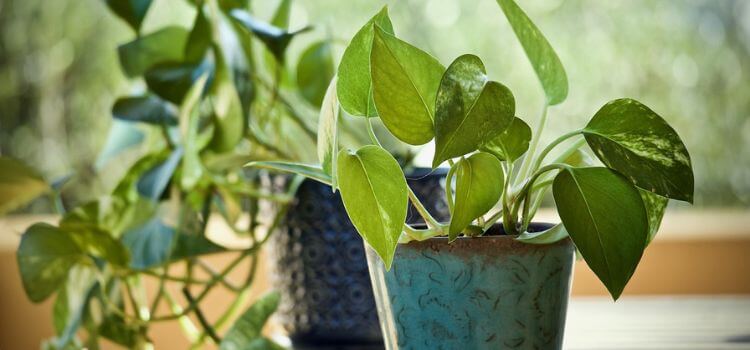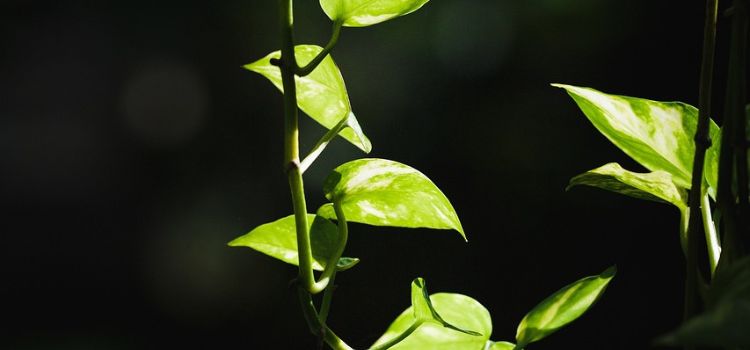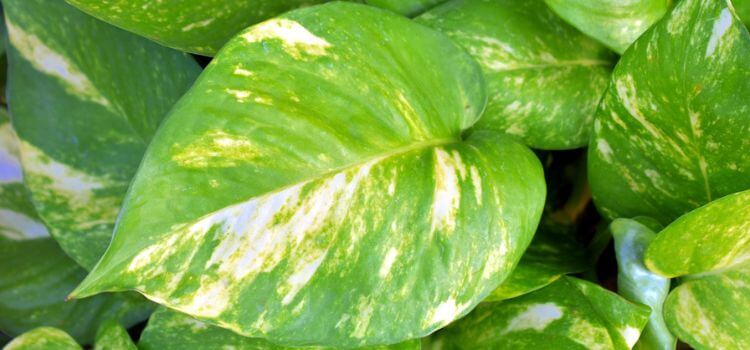As an Amazon Associate, I earn from qualifying purchases.
Pothos leaves curl due to improper watering or environmental stress. Underwatering, overwatering, and temperature fluctuations are common causes.
Pothos, with their heart-shaped leaves and trailing vines, are popular houseplants because of their adaptability and low maintenance requirements. Yet, even these resilient plants, such as curling leaves, can display signs of distress. This phenomenon may perplex plant owners, but it indicates a discrepancy between the plant’s care and environmental needs.
While pothos are forgiving, they communicate their discomfort, with curling leaves acting as a signal for immediate attention. This is where your role as a plant owner comes in. Ensuring a healthy pothos requires understanding the delicate balance of watering, light, and temperature that these plants thrive under.
Common Pothos Leaf Curling Causes
Pothos plants are hardy but can show stress. Leaf curling is one sign. The following are common causes.
Improper Watering Practices
Watering is crucial for plant health. Too much or too little affects pothos leaves.
- Overwatering: Leaves curl, feel soft, and may be yellow.
- Underwatering: Leaves curl, look dry, and edges brown.
Check soil moisture. Water when the top inch feels dry.
Low Humidity Levels
Pothos thrive in moist environments. Low humidity dries leaves out, causing curling.
- Use a humidifier.
- Place a water tray near the plant.
- Mist leaves regularly.
Inadequate Lighting
Lighting affects pothos growth. Direct sunlight scorches leaves. Too little light makes them reach and curl.
| Condition | Impact on Pothos |
|---|---|
| Too Much Light | Leaves curl, discolour, and can burn. |
| Too Little Light | Leaves stretch, curl, and become pale. |
Find a spot with indirect, bright light. Monitor changes and adjust as needed.
Pests And Diseases
Pests and diseases often cause pothos leaves to curl, a sign that the plant is in distress. Identifying the culprit is crucial for the health of your pothos. Let’s explore common issues like spider mites and root rot.

Spider Mites Infestation
Spider mites are tiny pests that suck the sap from plants. They leave behind telltale webbing. Curled leaves on a pothos may indicate an infestation. Look for these signs:
- Small, yellow, or brown spots on the leaves
- Delicate webs, especially on the underside of leaves
- A dusty look on the plant
To fight spider mites:
- Isolate the affected plant.
- Wipe the leaves with a soft, damp cloth.
- Use insecticidal soap or neem oil for treatment.
Root Rot
Root rot is a severe condition caused by overwatering. It leads to decay in the root system. This impacts the pothos’ ability to absorb water and nutrients. To check for root rot:
- Remove the plant from its pot.
- Examine the roots for black or brown discoloration.
- Smell the roots. A lousy odor indicates rot.
For a plant with root rot, trim the affected roots—Repot in fresh, well-draining soil. Ensure proper pot drainage to prevent future occurrences.
Environmental Factors
Pothos plants thrive in a stable environment, yet sometimes their leaves start to curl. This can signal distress. Environmental factors play a vital role in the health of your pothos.
Temperature Fluctuations
Pothos plants are most comfortable in a consistent temperature range. Drastic temperature fluctuations can stress the plant, leading to curled leaves. It’s in your hands to provide the stable environment they need.
- Ideal temperature: 65-85°F (18-29°C)
- Avoid Sudden changes; keep away from heating or cooling vents
Drafts And Airflow
While some airflow is beneficial, too much can dehydrate pothos leaves, causing them to curl.
| Good Airflow | Bad Airflow |
|---|---|
| Gentle, indirect | Direct drafts from windows or AC units |
Protect your Pothos from harsh drafts to prevent leaf curling.
Nutritional Deficiencies
Nutritional deficiencies can cause your Pothos to have curled leaves. This distress signal indicates something is amiss with the plant’s diet.
Lack Of Nutrients
Your Pothos needs a balanced diet to thrive. Key nutPothos include nitrogen, phosphPothosand potassium. Without them, leaves may curl, signaling a cry for help.
- Nitrogen boosts leaf growth.
- Phosphorus supports root development.
- Potassium enhances overall health.
Regular potting mix might need these. Periodic fertilizing can prevent deficiencies.

Excess Fertilizer
Too much fertilizer can harm your Pothos. Salt buildup from over-fertilization can lead to curled leaves. It’s Pothos’s way of reducing exposure to these excess salts.
| Sign | Action |
|---|---|
| White crust on soil | Flush the soil with water. |
| Burnt leaf edges | Cut back on fertilizer use. |
Balance is key. Use a balanced, water-soluble fertilizer every 4-6 weeks during growing season.
Corrective Measures
Seeing your Pothos leaves curl can be a sign to change their care routine. Healthy Pothos display broad, flat leaves, so curled leaves need your attention. Here are steps to help your Pothos thrive again.
Adjusting Watering Routine
Too much or too little water causes Pothos leaves to curl. Follow these steps:
- Check soil moisture before watering.
- Allow the top inch of soil to dry between waterings.
- Use pots with drainage holes to prevent soggy soil.
- Water is less in winter when Potho’s growth slows down.
Increasing Humidity
Pothos love moist air. In dry environments, leaves curl to conserve moisture. Boost humidity like this:
- Place a humidifier near your plant.
- Group plants together to create a microclimate with higher humidity.
- Mist leaves regularly with water.
Improving Lighting Conditions
Correct light is crucial for Pothos. Ensure your plant gets the right amount:
- Position Pothos in bright, indirect light.
- Avoid direct sunlight, which can burn leaves.
- If leaves curl and yellow, move the plant away from too much light.
- Rotate your plant regularly for even light exposure.
Pest And Disease Management
Pest and Disease Management is crucial for the health of your Pothos plant. Curling leaves often signal such issues. Identifying and treating these problems can save your plant.
Natural Remedies For Spider Mites
Spider mites are tiny pests that suck sap from leaves, causing them to curl and wilt. Combat these pests naturally with the following steps:
- Isolate the affected plant to prevent spread.
- Wipe leaves with a soft, damp cloth to remove mites.
- Create a homemade miticide using water and a few drops of dish soap.
- Spray the plant thoroughly, focusing on the undersides of the leaves.
- Repeat the treatment weekly until the mites disappear.
Preventing Root Rot
Root rot is a common issue in Pothos plants, often caused by overwatering. Prevent this disease with proper care:
| Prevention Tips | Details |
|---|---|
| Well-draining soil | Use a potting mix that allows excess water to escape. |
| Proper watering | Water only when the top inch of soil is dry to the touch. |
| Adequate pot size | Ensure the pot is not too large, which can hold excess moisture. |
| Monitor | Check for signs of stress and adjust care accordingly. |
Creating An Ideal Environment
Curling leaves on a Pothos plant can signal an unhappy environment. To ensure your Pothos thrives, creating the ideal conditions is crucial. This section guides you through maintaining stable temperatures and minimizing drafts, which are critical factors for healthy Pothos leaves.
Maintaining Stable Temperatures
Pothos plants prefer a steady temperature between 65°F to 85°F (18°C to 29°C). Sudden changes can stress the plant, leading to curled leaves. Consider these steps:
- Avoid placing Pothos near heaters or air conditioners.
- Keep the plant away from cold windows during winter.
- Use a thermometer to monitor room temperature.
Your Pothos will display lush, flat leaves by keeping the temperature consistent.
Minimizing Drafts
Drafts can be as harmful as temperature swings. They dry out leaves, causing them to curl. To protect your Pothos:
- Ensure it’s not in the path of an open window or door.
- Shield the plant with a decorative screen if needed.
- Check for gaps in windows and seal them to prevent cold air from entering.
With draft protection, your Pothos will likely maintain healthy, vibrant foliage.
Balanced Nutrition
Healthy pothos plants need balanced nutrition to thrive. Curled leaves often signal a lack of essential nutrients. Just as a balanced diet keeps us healthy, pothos plants require the right mix of nutrients to prevent leaf curling.
Identifying And Addressing Nutrient Deficiencies
Pothos leaves curling might mean your plant is starving for nutrients. Look for signs like yellow leaves or stunted growth. These symptoms hint at a deficiency.
Everyday nutrient needs:
- Nitrogen – For leaf growth
- Phosphorus – For root health
- Potassium – For overall vitality
Test your soil to confirm what’s missing. Soil testing kits are simple to use and available at most garden centers. After identifying the gaps, you can seek the right fertilizer.
Fertilizing Tips
Refrain from over-fertilizing, as this can harm your pothos. Here’s how to do it right:
- Use a balanced, water-soluble fertilizer.
- Apply every 4-6 weeks during growing seasons.
- In winter, reduce the frequency.
Remember, proper nutrition keeps your pothos’ leaves lush and vibrant.
Frequently Asked Questions On Why Are My Pothos Leaves Curling?
To fix curled pothos leaves, ensure proper watering, avoiding over and under-watering. Provide bright, indirect light and maintain a consistent temperature. Check for pests and treat if necessary. Adjust humidity levels and use well-draining soil to promote healthy growth.
An overwatered pothos exhibits yellowing leaves, limp stems, and sometimes black or brown mushy spots on the foliage. Leaves may also drop prematurely.
Identify the causes of curling leaves, such as pests, disease, water stress, or nutrient deficiencies. Treat pests or diseases appropriately, ensure proper watering, and adjust soil nutrients with fertilizer. Monitor plant recovery and maintain consistent care.
Water a pothos plant every 1-2 weeks, allowing soil to dry out between waterings. Adjust the frequency based on light levels and humidity.
Conclusion
Understanding why your pothos leaves curling is critical to ensuring a healthy, vibrant plant. Paying attention to watering habits, light exposure, and the general environment can prevent future issues. Addressing these common causes can help your pothos thrive and maintain its lush, green beauty.

